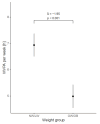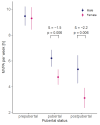Effects of weight status, sex, age, sedentary behavior, pubertal status and socioeconomic status on the physical activity of children and adolescents
- PMID: 40335978
- PMCID: PMC12057131
- DOI: 10.1186/s12889-025-22867-1
Effects of weight status, sex, age, sedentary behavior, pubertal status and socioeconomic status on the physical activity of children and adolescents
Abstract
Background: Physical inactivity, especially in the context of the worldwide childhood obesity epidemic, is still a growing public health concern. Moreover, both physical inactivity and overweight often become ingrained and subsequently persist into adulthood. Therefore, the main purpose of this study was to investigate how weight status, sex, age, sedentary behavior, pubertal status and socioeconomic status influence physical activity levels in children and adolescents.
Methods: This study utilized accelerometer data (SenseWear Pro 2, Bodymedia) to explore correlations between the outcome variable physical activity levels and the predictor variables weight status, sex, age, sedentary behavior, pubertal status and socioeconomic status. We analyzed 847 observations from 397 children and adolescents between the ages of 5.9 and 17.9 years, employing linear mixed-effect regression models. Roughly 55% of participants were categorized as overweight, 45% normal- or underweight.
Results: A mere 18% of the cohort met the World Health Organization`s activity recommendations for 60 min of moderate to vigorous physical activity (MVPA) per day on weekdays. Specifically, children classified as overweight/obese participated less frequently in MVPA compared with their normal or lower weight peers. Children 14 years of age or younger with overweight or obesity were 30 min less active per day on weekends (p < 0.001). Furthermore, girls were less active than boys. This effect was most pronounced on weekends for those between the ages of 14 and 17.9, when girls engaged in 21 fewer min of MVPA (p = 0.013). Across all participants, every year older corresponded to a weekly decrease in MVPA of approximately 47 min (p < 0.001). Additionally, MVPA levels declined significantly with advancing pubertal stage, with postpubertal adolescents accumulating 4.1 h less MVPA than their prepubertal peers (p < 0.001). Low socioeconomic status was associated with an 18-minute reduction in MVPA (p = 0.016) on weekends, but only in boys.
Conclusion: These findings demonstrate a significant association between physical activity levels and the examined predictors, highlighting the importance of addressing multiple factors to enhance physical activity engagement. The results underscore the need for a multifaceted, targeted approach at enhancing physical activity levels and improving child health, curbing the ongoing prevalence of overweight and obesity in childhood and subsequent adulthood.
Keywords: Accelerometer; Adolescent; Child; MVPA; Obesity; Physical activity.
© 2025. The Author(s).
Conflict of interest statement
Declarations. Ethics approval and consent to participate: The LIFE Child Study is conducted in accordance with the Declaration of Helsinki and has received ethical approval from the Ethical Committee of the Medical Faculty, University of Leipzig (reg. no. 477/19-ek, 09.10.2020). It is registered at https://clinicaltrials.gov/ (NCT02550236). Informed written consent is obtained from all parents or legal guardian as well as children over the age of 12 years. Consent for publication: Not applicable. Competing interests: The authors declare no competing interests.
Figures
Similar articles
-
Objectively assessed physical activity and weight status in Maltese 11-12 year-olds.Eur J Sport Sci. 2014;14 Suppl 1:S257-66. doi: 10.1080/17461391.2012.691113. Epub 2012 Jun 19. Eur J Sport Sci. 2014. PMID: 24444216
-
Trends and correlates of overweight/obesity in Czech adolescents in relation to family socioeconomic status over a 12-year study period (2002-2014).BMC Public Health. 2018 Jan 10;18(1):122. doi: 10.1186/s12889-017-5013-1. BMC Public Health. 2018. PMID: 29321055 Free PMC article.
-
School-time physical activity among Arab elementary school children in Qatar.BMC Pediatr. 2017 Mar 15;17(1):76. doi: 10.1186/s12887-017-0832-x. BMC Pediatr. 2017. PMID: 28298199 Free PMC article.
-
Accelerometer-measured physical activity and sedentary behavior in Chinese children and adolescents: a systematic review and meta-analysis.Public Health. 2020 Sep;186:71-77. doi: 10.1016/j.puhe.2020.07.001. Epub 2020 Aug 9. Public Health. 2020. PMID: 32784098
-
Longitudinal changes in moderate-to-vigorous-intensity physical activity in children and adolescents: A systematic review and meta-analysis.Obes Rev. 2020 Jan;21(1):e12953. doi: 10.1111/obr.12953. Epub 2019 Oct 23. Obes Rev. 2020. PMID: 31646739 Free PMC article.
References
-
- World Health Organization, Fact sheet „Obesity and Overweight, accessed. December 2023, https://www.who.int/news-room/fact-sheets/detail/obesity-and-overweight
-
- Bass R, Eneli I. Severe childhood obesity: an underrecognised and growing health problem. Postgrad Med J. 2015;91(1081):639–45. 10.1136/postgradmedj-2014-133033 - PubMed
-
- Prentice-Dunn H, Prentice-Dunn S. Physical activity, sedentary behavior, and childhood obesity: A review of cross-sectional studies. Psychol Health Med. 2012;17(3):255–73. 10.1080/13548506.2011.608806 - PubMed
MeSH terms
LinkOut - more resources
Full Text Sources
Medical
Miscellaneous




